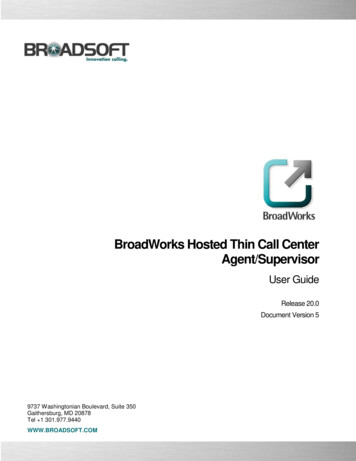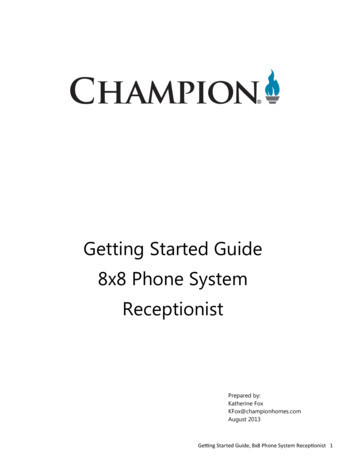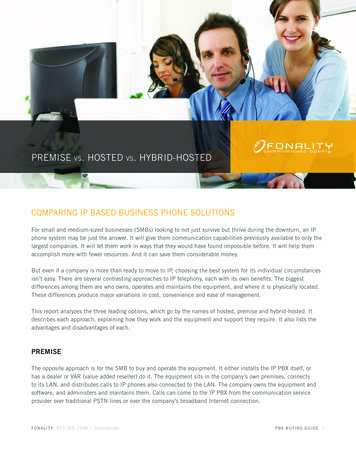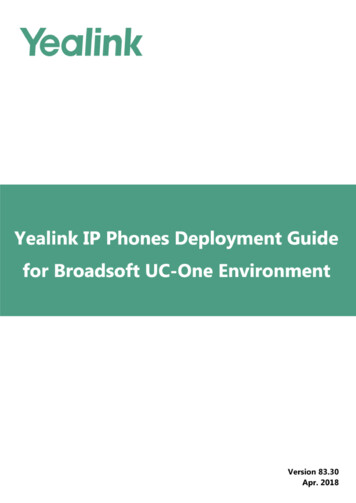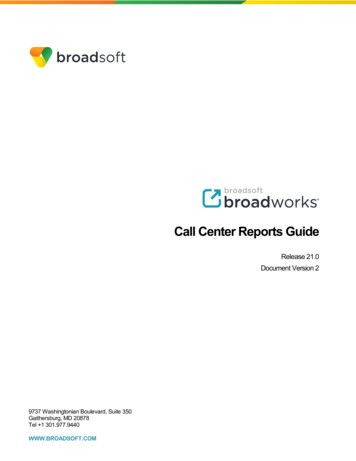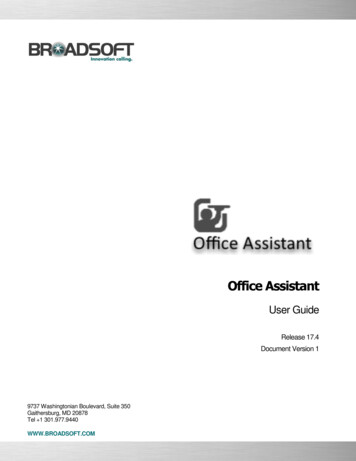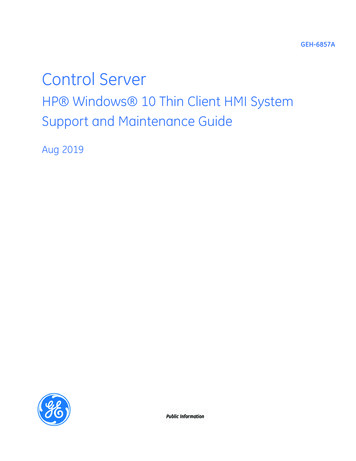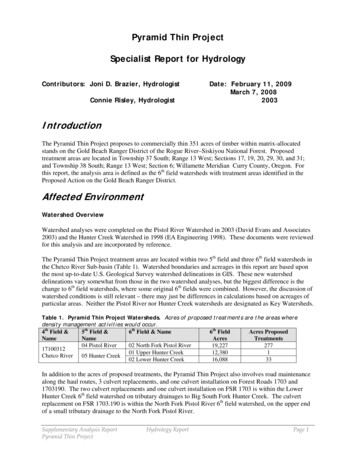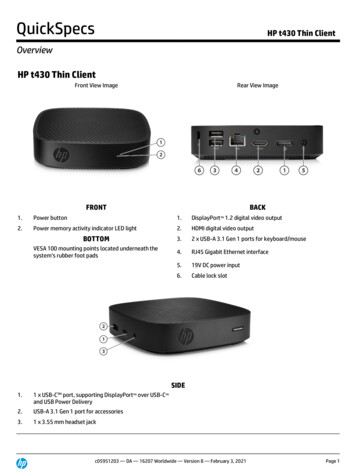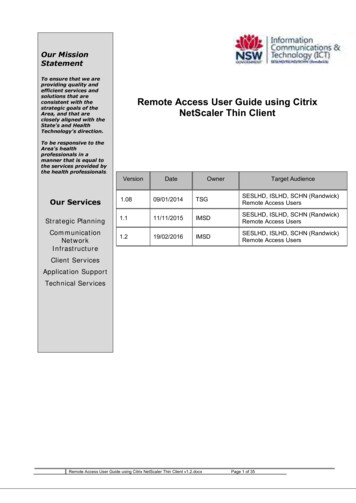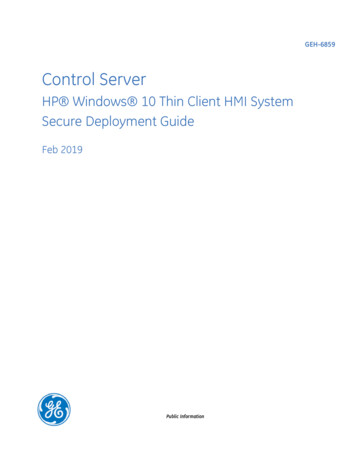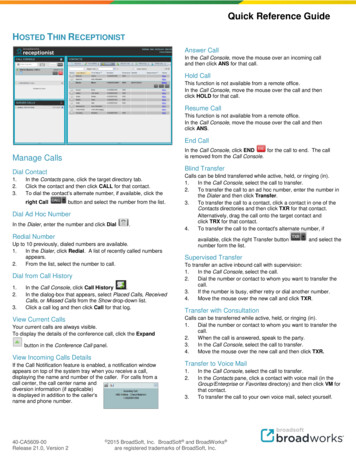
Transcription
Quick Reference GuideHOSTED THIN RECEPTIONISTAnswer CallIn the Call Console, move the mouse over an incoming calland then click ANS for that call.Hold CallThis function is not available from a remote office.In the Call Console, move the mouse over the call and thenclick HOLD for that call.Resume CallThis function is not available from a remote office.In the Call Console, move the mouse over the call and thenclick ANS.End CallIn the Call Console, click ENDfor the call to end. The callis removed from the Call Console.Manage CallsBlind TransferDial Contact1.2.3.In the Contacts pane, click the target directory tab.Click the contact and then click CALL for that contact.To dial the contact’s alternate number, if available, click theright Callbutton and select the number from the list.Dial Ad Hoc NumberIn the Dialer, enter the number and click Dial.Calls can be blind transferred while active, held, or ringing (in).1.In the Call Console, select the call to transfer.2.To transfer the call to an ad hoc number, enter the number inthe Dialer and then click Transfer.3.To transfer the call to a contact, click a contact in one of theContacts directories and then click TXR for that contact.Alternatively, drag the call onto the target contact andclick TRX for that contact.4.To transfer the call to the contact's alternate number, ifRedial NumberUp to 10 previously, dialed numbers are available.1.In the Dialer, click Redial. A list of recently called numbersappears.2.From the list, select the number to call.Dial from Call History1.2.3.In the Call Console, click Call History.In the dialog-box that appears, select Placed Calls, ReceivedCalls, or Missed Calls from the Show drop-down list.Click a call log and then click Call for that log.View Current CallsYour current calls are always visible.To display the details of the conference call, click the Expandbutton in the Conference Call panel.available, click the right Transfer buttonnumber form the list.and select theSupervised TransferTo transfer an active inbound call with supervision:1.In the Call Console, select the call.2.Dial the number or contact to whom you want to transfer thecall.3.If the number is busy, either retry or dial another number.4.Move the mouse over the new call and click TXR.Transfer with ConsultationCalls can be transferred while active, held, or ringing (in).1.Dial the number or contact to whom you want to transfer thecall.2.When the call is answered, speak to the party.3.In the Call Console, select the call to transfer.4.Move the mouse over the new call and then click TXR.View Incoming Calls DetailsIf the Call Notification feature is enabled, a notification windowappears on top of the system tray when you receive a call,displaying the name and number of the caller. For calls from acall center, the call center name anddiversion information (if applicable)is displayed in addition to the caller’sname and phone number.40-CA5609-00Release 21.0, Version 2 2015Transfer to Voice Mail1.2.3.In the Call Console, select the call to transfer.In the Contacts pane, click a contact with voice mail (in theGroup/Enterprise or Favorites directory) and then click VM forthat contact.To transfer the call to your own voice mail, select yourself.BroadSoft, Inc. BroadSoft and BroadWorks are registered trademarks of BroadSoft, Inc.
HOSTED THIN RECEPTIONISTTransfer to Queue (Enterprise Edition)End Conference1.2.3.To end the conference, click End in the Conference Call panelheader. The calls are terminated and removed from theConference Call panel.In the Call Console, select the call to transfer.In the Contacts pane, click the Queues tab.Click a queue and then click TXR for that queue.Camp on Busy Contact(Enterprise and Small Business Editions)You can camp external calls trying to reach a busy extension.The call is transferred when the destination becomesavailable.1.In the Call Console, select the call to camp.2.In the Group/Enterprise or Favorites directory, click a busy orringing contact and then click CAMP for that contact. The callis camped and removed from the Call Console.3.If the call timer expires before the call is answered, the call isrecalled to your device and reappears in the Call Console.Group Call Park (Enterprise Edition)This feature searches within a predefined hunt group for anavailable line to park a call.1.In the Call Console, click an active or held call and then clickPARK for that call. The call is parked on an availableextension and then removed from the Call Console.2.If the call timer expires before the call is answered, the call isrecalled to your device and reappears in the Call Console.Directed Call PickupYou can answer a call on behalf of another person.1.In the Contacts pane, click the Group/Enterprise or Favoritesdirectory tab.2.Click a ringing contact and click ANS. The call appears in theCall Console.Start Three-Way Conference1.2.3.If necessary, place calls to participants.In the Call Console, select one of the calls to conference.Move the mouse over the non-selected call and then clickCONF. The calls are moved to the Conference Call panel.Barge In on Call1.2.Click the target directory tab.Click a busy contact and then click BARGE. A Three-WayConference is established.Sent E-mail to Contact1.2.3.Click the target directory tab.Click a contact with e-mail and then click EMAIL.In the message window that appears, enter the requiredinformation and then click Send.View Call History1.2.In the Call Console, click Call History. The Call Historydialog box displays your placed, received, and missed calls.To view call logs in a group, select the group from the Showdrop-down list.Delete Call Logs1.2.In the Call Console, click Call Historydialog box appears.To delete all call logs, click Delete All. The Call History3.To delete a specific log, click Delete Call Logfor that log.Receive Calls from QueuesTo start or stop receiving calls from queues:1.Click the Settings link at the top right-hand corner of the maininterface and then click the Application tab.2.In the Queue Memberships section, check the Queue box foreach call center to join.3.In the Operator Policies section, select your Post Sign-In ACDState from the drop-down list.Hold ConferenceEnable Call Waiting and Auto AnswerTo hold the conference, in the Conference Call panel header,click HOLD.1.To enable Call Waiting, click Call WaitingConsole.2.To enable Auto Answer, click Auto Answerin the CallConsole.Note that this feature works only if your device isAdvanced Call Control (ACC)-compliant. In addition, ifAuto Answer is enabled on the server, you must notenable Auto Answer in the client.Resume ConferenceTo resume the conference, in the Conference Call panelheader, click ANS.Hold or Resume Conference Participant To place a participant on hold, click HOLD for the targetcall.To resume a participant, click ANS for the target call.in the CallLeave ConferenceTo leave the conference, click LEAVE in the Conference Callpanel header. The other parties stay connected but the callsare removed from the Conference Call panel. Note that youcan only leave a Three-Way conference.PAGE 2 of 5
HOSTED THIN RECEPTIONISTReceptionist Interface Total call time, including the time in the current queue (inparentheses)The main elements of the Receptionist interface include: Call Console Contacts Pane Queued Call Pane (Enterprise Edition) Setting and Help LinksClicking a call expands the call to show additional data: Call priority bucket (Premium call center) Position of call in queue Name and number of the calling party (if available)Call ConsoleSettings, Full Screen, and Help LinksThe Call Console is where you manage your current calls. Itcontains the following: The main area of the Call Console lists your current callsand allows you to perform actions on them. Dialer – This allows you to make ad hoc calls and redialup to 10 of the most recently dialed numbers. Conference panel – This lists the call legs of yourcurrent conference call and allows you to take actions onconference calls. For each call, the name and the phone number of theremote party (if available), the call state, the duration ofthe call, and for held calls, the time the call has been onhold, are displayed. For a recalled call, informationabout the user, against whom the call had been parked,also appears.Contacts PaneYou use the Contacts pane to call, monitor, and manage yourcontacts. The pane lists available contact directories. Favorites – Contacts whose status you are (statically)monitoring, which are configured on the web portal Group/Enterprise – Contacts in your enterprise or group Group/Enterprise Common – Contacts in your group’sor enterprise’s common phone list on BroadWorks Personal – Contacts in your Personal directory onBroadWorks Speed Dial – Speed dial numbers configured for yourSpeed Dial 8 and/or Speed Dial 100 service Queues (Enterprise Edition) – Your call centers Custom (Enterprise Edition) – Contacts in your customdirectories on the web portal Managed Contacts (Enterprise Edition) – Containsdynamically managed contacts.The Contacts pane also contains the Search tab andcapabilities, which you use to search for contacts.Queued Calls Pane (Enterprise Edition)You use the Queued Calls pane to manage queued calls. Thispane displays calls in selected call centers that you aremanaging. For each call, the following information is provided: Call Status icon, which can be:– Call is waiting to be answered–Message is being played to caller–Call was reordered The Settings link, when clicked, displays the Settingspage, allowing you to configure Receptionist.The Full Screen link, when clicked, displays theReceptionist main window in full-screen mode.The Help link, when clicked, opens the BroadWorksHosted Thin Receptionist User Guide in PDF format.Manage ContactsShow Directories1.2.3.At the top of the Contacts pane, click the drop-down arrowto the right of the directory tabs.From the list that appears, select the directory to display. Thedirectory tab displays at the top of the Contacts pane and itscontents appear in the Contacts pane.To remove a directory tab from the Contacts pane, click theClosebutton on the tab for that directory.Monitor Contacts StaticallyThe Favorites directory, configured on the web portal, displaysthe phone state of contacts. This is called static monitoring.Monitor Contacts Dynamically (Enterprise Edition)In the Group/Enterprise directory, click the contact’s statusicon. The contact is monitored and added to the MonitoredContacts directory. This is referred to as dynamic monitoring.Contact Phone StatesThe possible contact phone states area Call,Ringing,Forwarding, andDo Not Disturb,Available,OnPrivate,Unknown.NOTE: If a call is parked against a contact that you aremonitoring, either statically or dynamically, the informationabout the parked call also appears.Make Notes about Contact (Enterprise Edition)You can make notes about contacts in the Group/Enterprise,Favorites, Custom, or Monitored directories.1.Click the target directory tab.2.Click the Notes link for the contact.3.Enter or modify information in the Notes for Contact Name dialog box.4.To save your changes and close the dialog box, click OK.To close the dialog box without saving, click Cancel.–Call was bouncedName/number of the call center (or Dialed NumberIdentification Service [DNIS], if applicable)PAGE 3 of 5
HOSTED THIN RECEPTIONISTManage Speed Dial and Personal DirectoriesTransfer Call to Queue1.1.2.3.4.In the Speed Dial or Personal tab, click Edit. The EditSpeed Dials/Edit Personal Contacts dialog box appears.To add an entry, click Add. A new row appears.– For a Speed Dial entry, select the dial code and enter thenumber and description of the contact.– For a Personal entry, enter the name and number.Do delete an entry, select the entry, and then click Delete.To modify a Speed Dial entry, double-click the entry to make iteditable and then modify it as necessary.2.3.In the Queued Calls pane, expand a Call Center panel andthen select a queued call.In the Contacts pane, expand the Queues panel.Click a queue and then click TXR for that queue. The call istransferred to the bottom of the queue.Change Position of Call in Queue1.2.3.In the Queued Calls pane, expand a Call Center panel.Click the call and then click REORDER for that call.From the drop-down list that appears, select a new position.Note that you cannot modify a Personal entry.Note that you cannot place a call ahead of a bounced call.Perform Quick SearchTransfer Call to Top of Queue1.1.2.3.2.3.Select the directory to search and order it by the column tosearch.Check the Quick Search box.From the keypad that appears, select a single character. Thecontacts that start with the selected character (in the selectedcolumn) appear in the directory.Perform Regular Search1.2.3.4.5.6.Select the directory to search or click the Search tab to searchin all directories.If searching in a specific directory, make sure that the QuickSearch box is unchecked.In the Search text box, enter the text for which you want tosearch. You can enter partial information (at least twocharacters).To restrict the search to contacts that start with the enteredstring, check the Begins with box.If searching in a specific directory, select the column to searchby from the drop-down list. You can select a specific columnor all columns. In the Search tab, all columns are searched.Click the Search button.In the Queued Calls pane, expand a Call Center panel.Click the target call and then click REORDER for that call.From the drop-down list that appears, select Send to Front.Promote Call in Queue (Premium Call Center)1.2.In the Queued Calls pane, expand a Call Center panel.Click the call and then click PROMOTE. The call is moved tothe end of the next highest priority bucket.Transfer Call to Contact or Ad-Hoc Number1.2.3.In the Queued Calls pane, select a queued call.To transfer the call to a contact, click the contact in theContacts pane and then click TXR for that contact.To transfer the call to an ad hoc number, enter the number inthe Dialer and then click Transfer in the Dialer.Create Directory from Search Results1.Perform a search on a single column in a specific directory.2.When the results appear, click the Pullout button. A newtab is created that contains the results of the search.Once closed, a search results tab cannot be reopened.Manage Queues (Enterprise Edition)Display Queued CallsTo monitor calls in queues, you must select the queues todisplay in the Queued Calls pane.1.2.In the Queued Calls pane, click Optionsand select theEdit Queue Favorite Dialog menu item.In the dialog box that appears, check the call centers to displayand then click Save.Retrieve Call from Queue1.2.In the Queued Calls pane, expand a Call Center panel.Click the call and click RETRIEVE for that call. The callappears in the Call Console and you treat it as any other call.PAGE 4 of 5
HOSTED THIN RECEPTIONISTKeyboard ShortcutsKeyEquivalent Mouse ActionESCClick the Close buttonESCCancel the changes./Click the Dialer text box.?Click the Search text box.ARROWDOWNClick the scroll bar or the next item on a list.ARROW UPClick the scroll bar or the previous item on a list.PAGE DOWNScroll down one page.PAGE UPScroll up one page.1 .9Select a call in the Call Console.SPACEBARClick Answer on the selected incoming call in theCall Console. PERIOD Click End on a selected call in the Call Console.ENTERClick Dial.ENTERClick Search. Click Transfer in the Dialer.SHIFT 1.9Select a ringing call and click Answer.SHIFT 1.9Select an active call and click Hold.SHIFT 1.9Select a held call and click Retrieve.S or sClick on Settings link.B or bClick on the Back to Application link.R or rClick the Call History button.H or hClick the Help link.SHIFT L orSHIFT lClick the Sign Out link.in a dialog box.PAGE 5 of 5
call center, the call center name and diversion information (if applicable) is displayed in addition to the caller’s name and phone number. Answer Call In the Call Console, move the mouse over an incoming call and then click ANS for that call. Hold Call
